Best Hydroponics Layouts and Strategies in the Rimworld
Hydroponics basins have two advantages over the traditional stick-it-in-the-soil method of farming. The first advantage they have is enhanced fertility even over highly fertile soil. The second advantage is the ability to plant anywhere, even on sand, bare rock or steel flooring.
The disadvantages of hydroponics are that they must be powered and they have a build and maintenance cost. This material cost includes components, a valuable resource with many other competing uses. In comparison the fertility provided by good old fashioned dirt is free. The need for power exposes hydroponics to power disrupting events such as solar flares and eclipses.
There are also a number of crops that you can not grow in hydroponics basins: corn, cocoa, devilstrand mushrooms and haygrass.
The first stage of strategising hydroponics is to determine if we really need it at all. The advantage of enhanced fertility is ultimately just a space saving benefit. If you have plenty of space for farming then this is not a valuable benefit.
The advantage of fertility anywhere, is mainly for solving the problem of poor or non-existent soil fertility on your map. This problem is in desert and ice-sheet biomes, not really in any others.
Indoors VS Outdoors Hydroponics
From what I have seen, the majority of hydroponics enjoyers seem to think of hydroponics as a complement to sunlamps for growing indoors. This is not really true though. Sunlamps and hydroponics each solve very different problems. Sunlamps let you grow crops that need light under a roof where you can keep them warm during winter or protected from toxic fallout. Whereas hydroponics solve fertility problems.
There are only few biomes where both these problems will be an issue at the same time: ice-sheet, very cold deserts and of course toxic tiles. If your problem is only the cold not fertility, such as in cold bogs, boreal and tundra biomes, then you really only need sunlamps not hydroponics. Build your warmed, sunlamp powered, growing sheds over fertile soil instead.
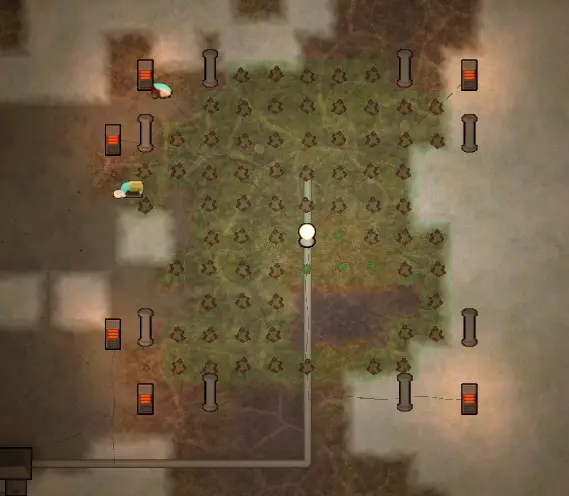
Natural sunlight, like soil, is free. If you can take advantage of free light you should do so. To do this the optimal hydroponic system will be outdoors, weather permitting.
An outdoor hydroponic system can still be enclosed by walls to protect from raiders, just leave it unroofed to the let the light in. You then have the option of temporarily roofing your walled hydroponics in case of cold snap or toxic fallout events. Without light, light sensitive crops will stall in growth but not die.
The Optimal Outdoor Hydroponic Layouts
In the great outdoors space saving is not really much of an issue. This is especially so given that the high productivity of hydroponics are already saving you space. More productivity means less tiles need to be devoted to crops. The main consideration for an efficient hydroponic layout outdoors is proximity to storage and production facilities and worker movement speed.
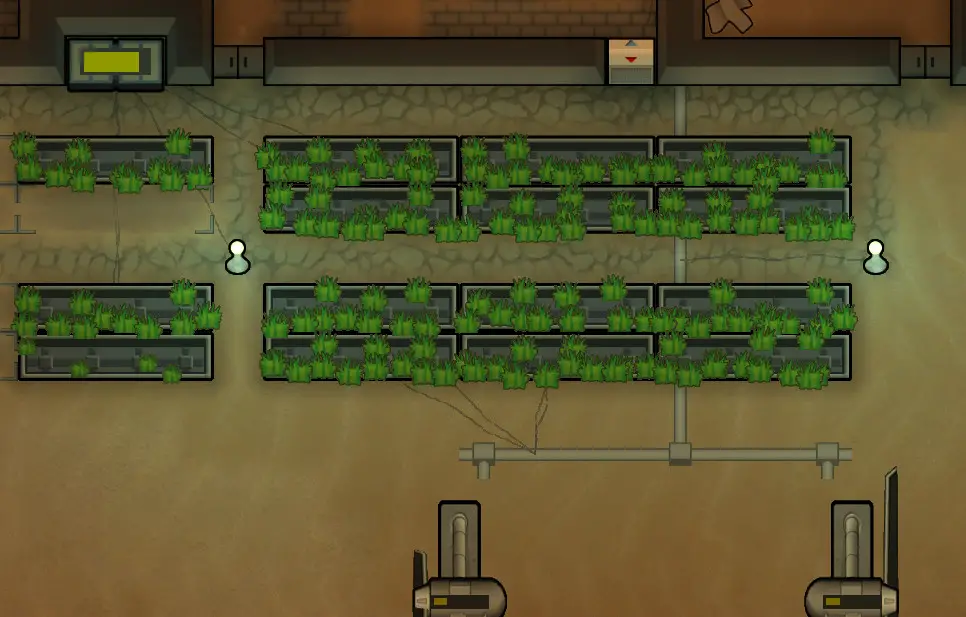
Hydroponics are passable by pawns but there is a movement penalty of 50% crossing them. The optimal hydroponics arrangement should allow for speedy access. That is if you are not hellbent on cramming as many hydroponics together as possible.
A hydroponics basin occupies 4×1 tiles. Workers can plant and harvest from adjacent tiles. So a good layout with a balance of access with space saving will have paired hydroponics extending out into rows as shown in the picture above.
If pawns will be transiting through this hydroponics area then try to line up the access paths with their likely routes.
The is no need to be very strict about this though. There is much to be gained from opportunistically sticking hydroponics wherever they can fit. See the picture below.
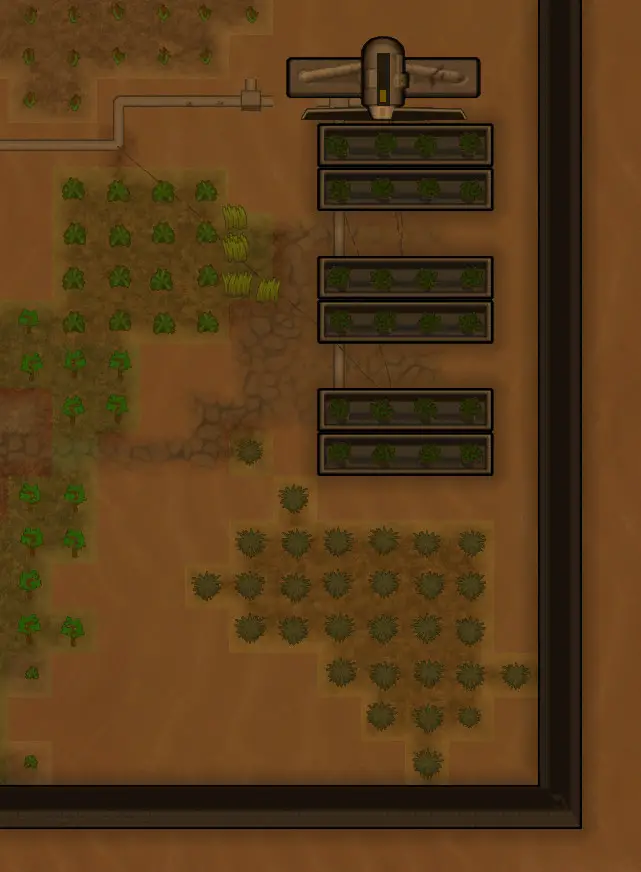
In this screenshot, there are patches of soil with low but usable fertility. You can fit hydroponics in just where there is no usable fertility.
The Optimal Indoor Hydroponic Layouts
With the exception of nutrifungus, every crop needs light to grow. Either they must have natural light available outside or the bright light of the sunlamp. An indoor hydroponic system must take into account the properties of sunlamps.
The Underground Space Saver
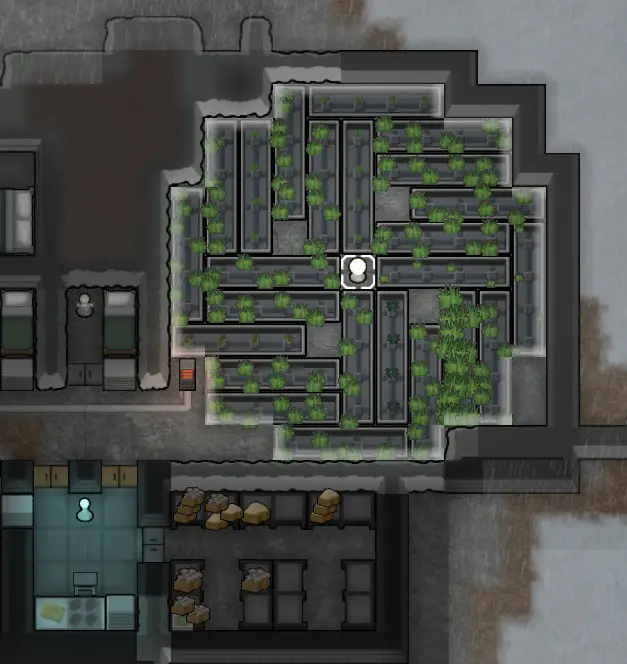
The space saving layout for hydroponics aims to pack as many hydroponics as possible within the aura of a sun lamp. This is the best layout for hydroponics dug out of mountains. It takes a lot more labour to dig out a space than it does to build a structure around an empty space.
In this layout pictured above, there are still four squares left over, in which can be put foampoppers, heaters, sculptures, shelving, roof columns or left open.
This layout fits 24 hydroponics under one sunlamp.
The Power Saver
The material cost to build sunlamps is only 40 steel. However sunlamps use a whopping 2700 Watts of power in the day (from 6am to 7pm). In comparison the total power needs of 24 hydroponics basins is 1680 Watts (70 Watts each). So the above layout called the space saver is also good for saving power since the minimal amount of sunlamp lit tiles is wasted.
More Light for Less
A sunlamp provides light to grow crops up to a 5 tile radius but also provides a weaker light out to an 11 tile radius. This weaker light is enough for working, removing darkness mood penalties and growing decorative plants. To really make use of every drop of power used by a sunlamp we can make use of this extra light too with a more open plan area.
Workbenches can be placed just outside of the primary lit aura to make use of this secondary light. This will save building and powering approximately 8 standing lamps per sunlamp. The maximum material saving will be 160 steel and maximum power saving will be 210 Watts (105 Watts with the advanced lighting technology). Although this is not a major saving to be fair.
However sunlamps only work in daylight hours, so this saving can be more when factoring in that standing lamps run 24 hours (unless manually switched off). You can schedule pawns to work only in this area within sunlamp hours. If you have pawns with the dark vision gene, you can schedule them to work the off hours when the area is dark.
This arrangement is also logistically efficient for workbenches that make use of the products of the hydroponics such as stoves (rice), breweries (hops), tailor benches (cotton) and drug labs (psychite, smokeleaf, cotton and herbal medicine).
Another way to use the weaker outer light aura of sunlamps is to grow fibrecorn. Uniquely fibrecorn only has a 30% light requirement.
Power Generation Efficiency
It is worth considering power generation here, since this layout is focused on saving power. Sun lamps use a lot of power in the day but none at night. You can use batteries to hedge this but they waste 50% of what they store. To maximise power efficiency it is best to feed power hungry sunlamps with solar panels which operate on the same schedule.
Depending on outside light conditions, a solar generator can output 1700 Watts. Thus two solar generators should be sufficient to power one sunlamp with some to spare.
The Fungus Specialiser
The last indoor hydroponics we will deal with is the one is not based around sunlamps at all. Nutrifungus is the one crop that does not want light at all. That being the case we can arrange hydroponics for them in a similar manner to outdoors hydroponics.
There is not much value in using in using hydroponics to grow nutrifungus however. Nutrifungus has a very low sensitivity to fertility (just 15%). This means the fertility multiplier of hydroponics is mostly doing nothing. It is best to grow Nutrifungus on soil or on fungal gravel (Tunneller meme) if at all possible. Or grow something else if not.
The best case for using hydroponics to grow nutrifungus is on a sea-ice biome where is no soil at all. A nutrifungus hydroponics farm at least has the advantage of low power requirements since no sunlamp is needed or wanted. This also makes it a crop that can be grown on a very small scale, even just one hydroponics basin.
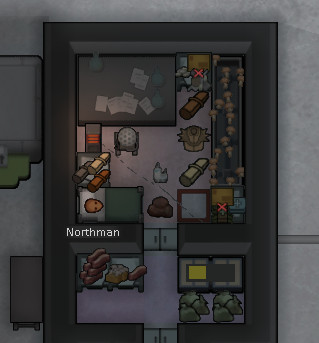
There we go a guide to hydroponics layouts for Rimworld. How do you organise your hydroponics? Let me know in the comments or share this article at my twitter @SolarCrossGames or my reddit community r/SolarCrossGames and let us chat about it.
Discover more of my Rimworld stories and articles by clicking here – Solar Cross’s Rimworld articles.
